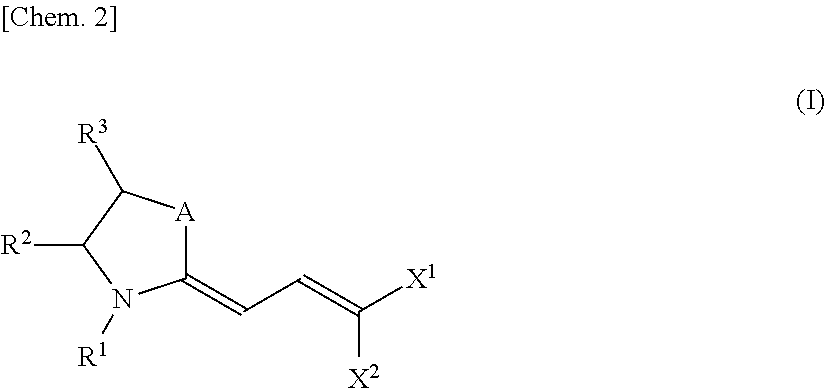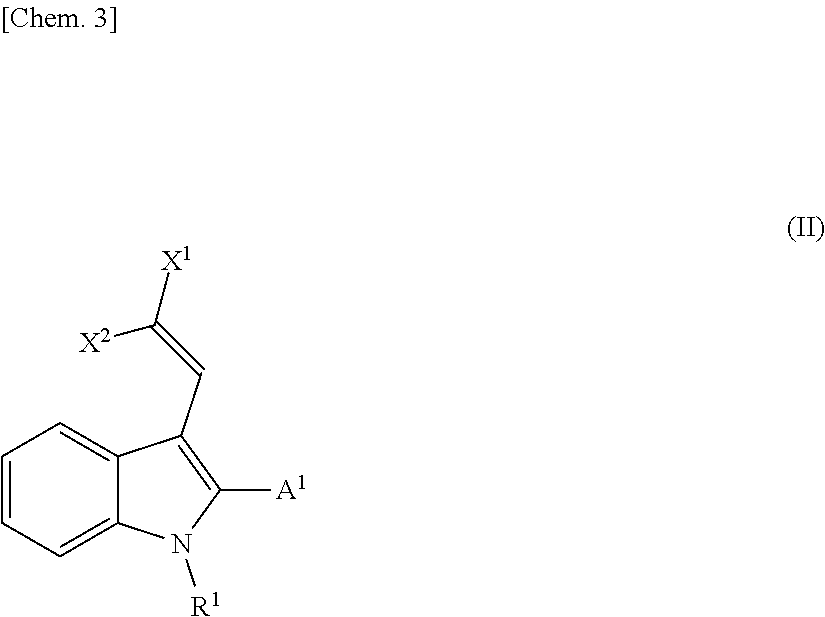Optical laminate
a technology of optical laminates and laminates, applied in the field of optical laminates, can solve the problems of difficult to obtain optical films, not necessarily satisfied in light fastness, etc., and achieve the effects of reducing structural members, high light fastness, and high absorption selectivity
- Summary
- Abstract
- Description
- Claims
- Application Information
AI Technical Summary
Benefits of technology
Problems solved by technology
Method used
Image
Examples
synthetic example 1
[0259]
[0260]A 100 mL-four-neck flask equipped with a Dimroth cooling tube and a temperature gage, in which the inside atmosphere was replaced with a nitrogen atmosphere was charged with 2.0 g of 2-phenyl-1-methylindole-3-carboxyaldehyde, 0.72 g of piperidine (manufactured by Wako Pure Chemical Industries, Ltd.), 1.3 g of butyl cyanoacetate (manufactured by Tokyo Chemical Industry Co., Ltd.), and 8 g of 1-butanol and the mixture was stirred by a magnetic stirrer. The mixture was heated in an oil bath and kept at an inside temperature of 80° C. for 18 hours. After the reaction was completed, the reaction mixture was cooled to ambient temperature and the precipitated crystals was collected by filtration, followed by drying the crystals under reduced pressure at 60° C., to obtain 2.7 g of UVA-01 as yellow powder. The yield was 87%. Also, maximum absorption wave length (λmax) was measured using a spectrophotometer UV-3150 (manufactured by Shimadzu Corporation), to find that λmax=386 nm (...
synthetic example 2
[0263]
[0264]A 200 mL-four-neck flask equipped with a Dimroth cooling tube and a temperature gage in which the inside atmosphere was replaced with a nitrogen atmosphere was charged with 10 g of UVA-M-02 powder synthesized with reference to Patent Document (JP-A-2014-194508), 3.7 g of acetic acid anhydride (manufactured by Wako Pure Chemical Industries, Ltd.), 5.8 g of 2-ethoxyethyl cyanoacetate (manufactured by Tokyo Chemical Industry Co., Ltd.), and 60 g of acetonitrile (manufactured by Wako Pure Chemical Industries, Ltd.) and the mixture was stirred by a magnetic stirrer. 4.7 g of N,N-diisopropylethylamine (hereinafter abbreviated as DIPEA, manufactured by Tokyo Chemical Industry Co., Ltd.) was added dropwise to the mixture from a dropping funnel for 1 hour and the mixture was then kept at an inside temperature of 25° C. for further 2 hours after the addition was finished. After the reaction was completed, acetonitrile was removed from the mixture by using a vacuum evaporator and i...
synthetic example 3
[0267]
[0268]A 100 mL-four-neck flask equipped with a Dimroth cooling tube and a temperature gage in which the inside atmosphere was replaced with a nitrogen atmosphere was charged with 3.0 g of 2-phenyl-1-methylindole-3-carboxyaldehyde, 1.2 g of piperidine (manufactured by Wako Pure Chemical Industries, Ltd.), 2.2 g of 2-ethoxyethyl cyanoacetate (manufactured by Tokyo Chemical Industry Co., Ltd.), and 12 g of acetonitrile (manufactured by Wako Pure Chemical Industries, Ltd.) and the mixture was stirred by a magnetic stirrer. The mixture was heated in an oil bath and kept at an inside temperature of 80° C. for 18 hours. After the reaction was completed, the reaction mixture was cooled to ambient temperature to remove acetonitrile by a vacuum evaporator. The obtained crude crystals were dissolved in toluene and the toluene solution was liquid-washed totally two times with 1% hydrochloric acid in a separatory funnel and, in succession, separately washed with pure water until the pH of ...
PUM
| Property | Measurement | Unit |
|---|---|---|
| wavelength | aaaaa | aaaaa |
| wavelength | aaaaa | aaaaa |
| absorption wavelength | aaaaa | aaaaa |
Abstract
Description
Claims
Application Information
 Login to View More
Login to View More - R&D
- Intellectual Property
- Life Sciences
- Materials
- Tech Scout
- Unparalleled Data Quality
- Higher Quality Content
- 60% Fewer Hallucinations
Browse by: Latest US Patents, China's latest patents, Technical Efficacy Thesaurus, Application Domain, Technology Topic, Popular Technical Reports.
© 2025 PatSnap. All rights reserved.Legal|Privacy policy|Modern Slavery Act Transparency Statement|Sitemap|About US| Contact US: help@patsnap.com



